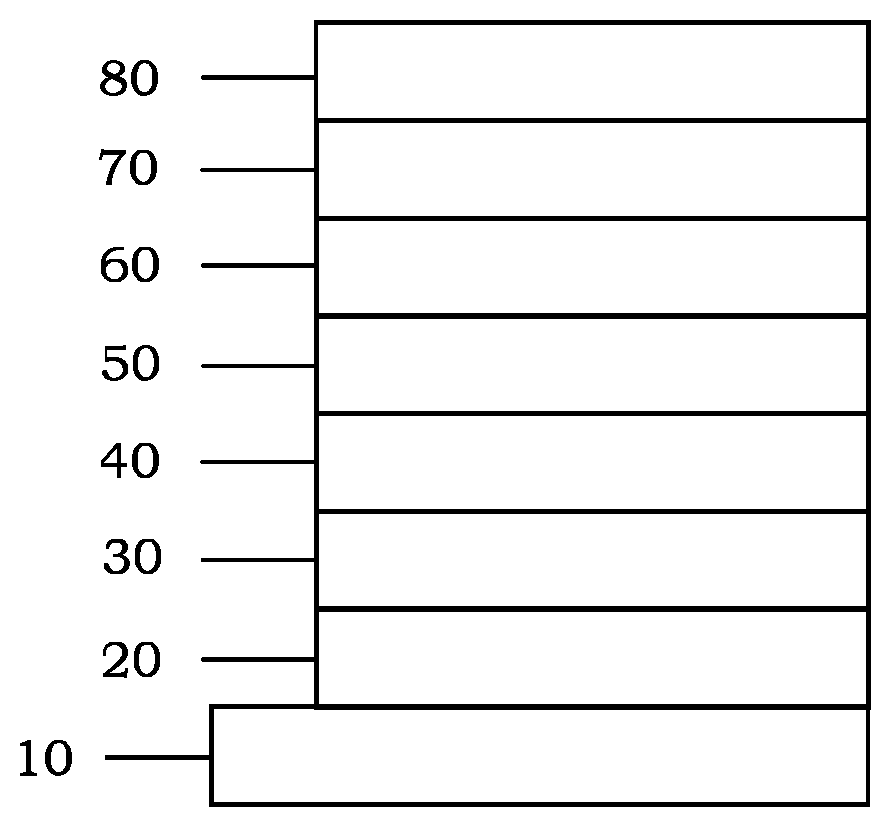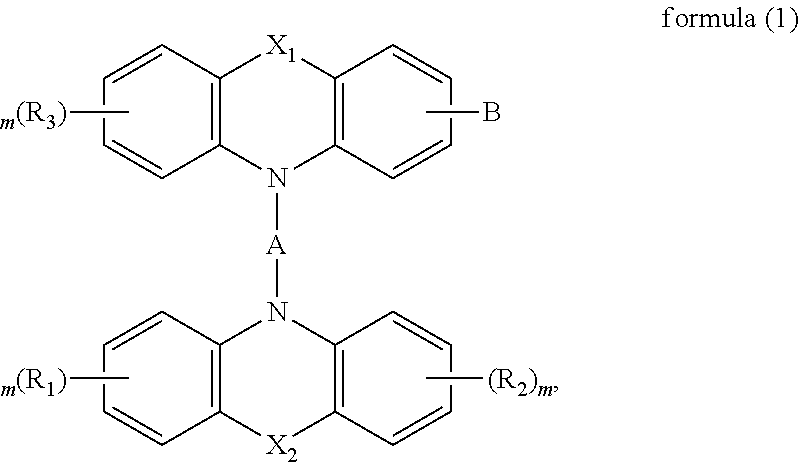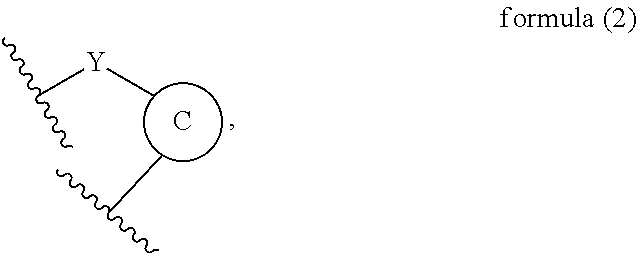Heteroaromatic compound and organic electroluminescence device using the same
a technology of organic el and compound, which is applied in the direction of luminescent compositions, organic chemistry, chemistry apparatus and processes, etc., can solve the problems of driving voltage, current efficiency, and half-life of organic el devices, so as to improve the current efficiency, power consumption, and life time of the device
- Summary
- Abstract
- Description
- Claims
- Application Information
AI Technical Summary
Benefits of technology
Problems solved by technology
Method used
Image
Examples
example 1
Synthesis of methyl 2-((9,9-dimethyl-9H-fluoren-2-yl)amino)-benzoate
[0028]
[0029]A mixture of 10 g (36.6 mmol) of 2-bromo-9,9-dimethyl-9H-fluorene, 6.64 g (43.9 mmol) of methyl 2-aminobenzoate, 0.3 g (1.46 mmol) of Pd(OAc)2, 17.9 g (54.9 mmol) of cesium carbonate, and 120 ml of o-xylene was degassed and placed under nitrogen, and then heated to reflux for 12 hrs. After the reaction was finished, the mixture was allowed to cool to room temperature. Subsequently, the solvent was removed under reduced pressure, and the crude product was purified by column chromatography, yielding 10 g of methyl 2-((9,9-dimethyl-9H-fluoren-2-yl)amino)benzoate as yellow oil (79.6%), 1H NMR (CDCl3, 400 MHz): chemical shift (ppm) 8.97 (s, 1H), 8.11 (d, 1H), 7.87 (d, 1H), 7.75-7.64 (m, 3H), 7.41-7.29 (m, 3H), 7.08 (m, 1H), 6.92 (d, 1H), 6.77 (d, 1H), 3.79 (s, 3H), 1.57 (s, 3H), 1.54 (s, 3H).
Synthesis of 2-(2-((9,9-dimethyl-9H-fluoren-2-yl)amino)phenyl)-propan-2-ol
[0030]
[0031]The compound methyl 2-((9,9-dimet...
example 2
Synthesis of 5-(5-bromonaphthalen-1-yl)-7,7,13,13-tetramethyl-7,13-dihydro-5H-indeno[1,2-b]acridine
[0038]
[0039]A mixture of 3.41 g (10.5 mmol) of 7,7,13,13-tetramethyl-7,13-dihydro-5H-indeno-[1,2-b]acridine, 3 g (10.5 mmol) of 1,5-dibromonaphthalene, 0.02 g (0.1 mmol) of Pd(OAc)2, 1.51 g (15.8 mmol) of sodium tert-butoxide, and 50 ml of o-xylene was degassed and placed under nitrogen, and then heated at 140° C. for 12 hrs. After the reaction was finished, the mixture was allowed to cool to room temperature. Subsequently, 150 ml of methanol was added, and then filtered and washed by methanol. The crude product was purified by column chromatography to get a yellow solid. Yield: 1.5 g, 27%. 1H NMR (CDCl3, 400 MHz): chemical shift (ppm) 8.09 (d, 2H), 7.93 (d, H), 7.84 (d, H), 7.55 (d, 2H), 7.45-7.41 (m, 2H), 7.37 (m, H), 7.26 (m, H), 7.07-7.03 (m, 3H), 6.76 (m, H), 6.69 (s, H), 6.56 (d, H), 1.56 (s, 6H), 1.39 (s, 6H).
Synthesis of 5-(7,7,13,13-tetramethyl-7,13-dihydro-5H-indeno-[1,2-b]ac...
example 3-9
[0042]We have used the same synthesis methods to get a series of intermediates and the following compounds are synthesized analogously.
[0043]
Ex.Intermediate IIntermediate IIProductYield356%443%541%647%754%845%939%
PUM
| Property | Measurement | Unit |
|---|---|---|
| EQE | aaaaa | aaaaa |
| EQE | aaaaa | aaaaa |
| internal quantum efficiency | aaaaa | aaaaa |
Abstract
Description
Claims
Application Information
 Login to View More
Login to View More - R&D
- Intellectual Property
- Life Sciences
- Materials
- Tech Scout
- Unparalleled Data Quality
- Higher Quality Content
- 60% Fewer Hallucinations
Browse by: Latest US Patents, China's latest patents, Technical Efficacy Thesaurus, Application Domain, Technology Topic, Popular Technical Reports.
© 2025 PatSnap. All rights reserved.Legal|Privacy policy|Modern Slavery Act Transparency Statement|Sitemap|About US| Contact US: help@patsnap.com



